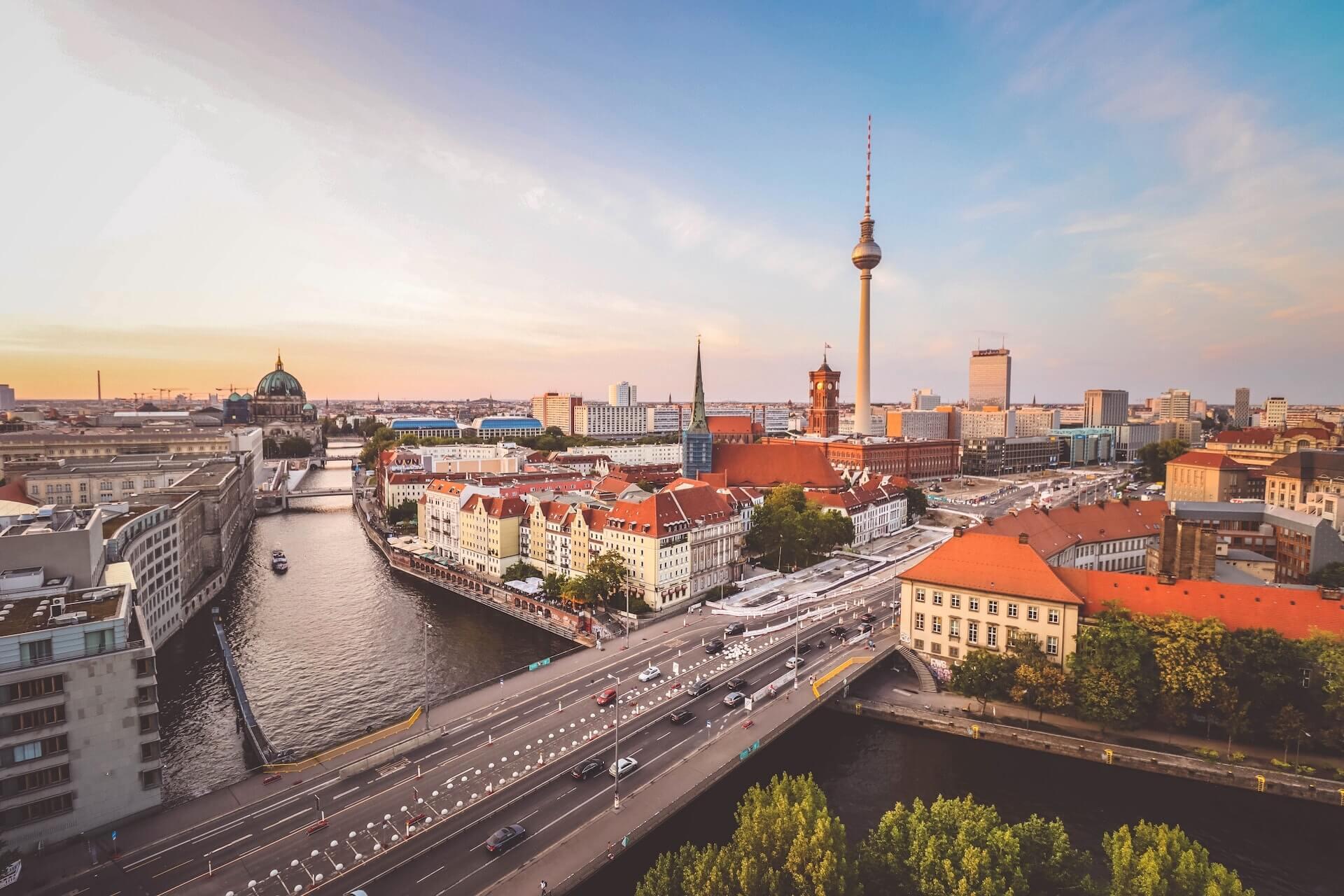One of Europe's largest cities and the second largest city in the European Union, Berlin has been the capital of Germany since 1991. There is something for everyone in Berlin! This modern metropolis offers sophisticated shopping galleries with luxury goods, but also quaint marketplaces; impressive architectural monuments, and also old and dilapidated buildings. You can enjoy wild nightlife, important historical monuments and beautiful parks full of greenery. Before you head to Berlin, read our city guide for proven information on accommodation, transport, dining and sightseeing tips!
Arriving in the city
You can get to Berlin by car, train, bus or plane. What's most convenient for you depends on where you're travelling from.
Berlin's largest railway station is the Berlin Hauptbahnhof (main station), which opened in 2006 after about ten years of construction and is one of the city's most important landmarks, not only from a technical point of view. The station is located on the river Spree near the Humboldt harbour.
Another transport option to Berlin is by bus. You can find companies such as RegioJet, FlixBus and Eurolines buses.
Buses usually stop at Am Funkturm, located in the Charlottenburg district, approximately 17 km from the city centre. There are excellent public transport connections from here. You can use the Kaiserdamm metro station – the U2 line will take you virtually to the city centre without changing trains – or the S-Bahn Mense Nord/ICC station (lines S41, S42, S46).
Schönefeld Airport is 18 km south of Berlin. It is served by rail and bus lines. To get to the city centre, take the RE7 and RB14 express trains, which run to Ostbahnhof, Alexanderplatz, Friedrichstraße, Berlin Hauptbahnhof and Zoologischer Garten. The journey takes around 25 minutes. The city centre area is served by trains S9, S45 and buses.
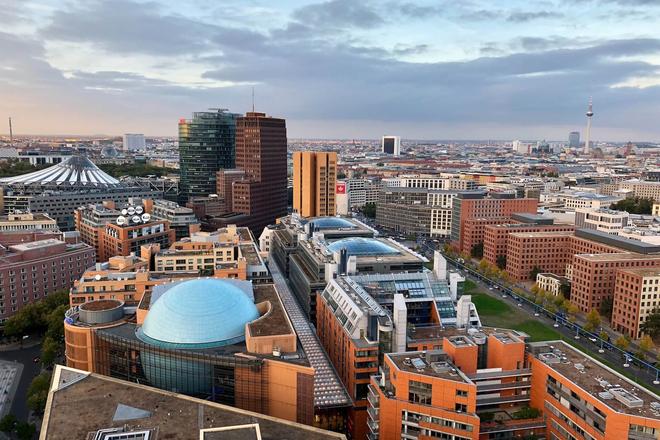
Public transport
Berlin's public transport network is one of the densest in Europe. It is a combination of metro, urban rail, tram and bus networks.
The Berlin Underground carries hundreds of thousands of passengers every day at peak times. All of Berlin's underground and some of its overground public transport is divided into two branches, the U-Bahn and the S-Bahn, which is convenient for orientation.
The city's U-Bahn metro is the backbone of public transport here. It consists of a total of nine different lines that cross the entire city, including the centre and the outskirts of Berlin. The metro runs at intervals of two (peak) to fifteen minutes (night service on some lines). At most stops you can transfer to interstate trains, the airport or a tram. The name of U-Bahn trains and railways begins with U and the trains are yellow.
The S-Bahn is the city's rapid transit line, offering very fast connections between key stations and linking the north, south, east and west of the city. It also reaches other towns and villages in the immediate vicinity of Berlin (Hönow, Rudow). There are currently 15 lines in operation, with all lines generally operating from approximately 4 to 1 h at 20-minute intervals, usually reduced to 10 minutes at peak times. The trains and tracks have the initial letter S and the trains are red and white in colour.
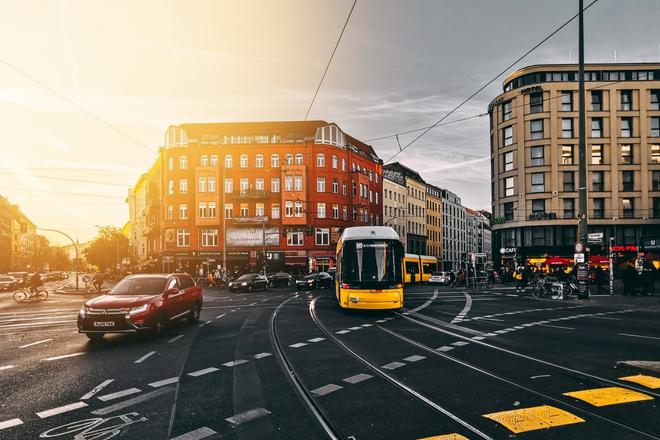
As for tickets, they can be bought at the ticket machines on the platforms or at newsagents. The city is divided into three payment zones – A = centre, B = outer city and C = outskirts of Berlin. With the cheapest ticket you can travel through three stations on S-Bahn and U-Bahn or six bus/tram stops, other tickets are time-based. The 2-hour transfer ticket is valid in all zones and for all means of transport. The day ticket is valid from the moment of stamping until 3am the following day. Stamp your ticket in advance on the platform in the machine. If you are travelling around Berlin in a group of at least three and up to five people, it is worth buying a group ticket, which serves the same purpose as a day ticket.
If you're coming to Berlin for sightseeing, check out the Berlin Welcome Card – a city pass for 48 hours, 72 hours or 5 days that offers 50% off more than 140 attractions in the city (museums, galleries, theatres, city guides, etc.).
You can also travel around Berlin by bike – everyone rides a bike here. You'll come across a rental shop on every corner, and rentals usually cost €12 per day. You can get around Berlin not only by bike, but perhaps also on a Segway, accompanied by an experienced guide, check out the Fat Tire Bike Tours website.
You may not expect much from your visit to Berlin, but you'll find yourself pleasantly surprised by a city full of life and greenery that will shock you with something interesting at every turn.
Orientation
At the centre of all the action is perhaps the city's most striking symbol and its main landmark, the Brandenburg Gate (stop Brandenburger Tor – S-Bahn S1, S2, S25, S26; bus 100, 200), which was located in the border zone during the Cold War and was not open to the public at all, but after the fall of the Iron Curtain became a symbol of German reunification and retains this significance to this day.
On the left side of the Brandenburg Gate, less than a ten-minute walk away, is the Holocaust Memorial (Behrenstr./Wilhelmstr. – bus 200, N2), which commemorates the 6,000,000 Jews who died in Nazi concentration camps. It is made of concrete blocks that give the impression of a cemetery.
Towards the other side, to the right of the Brandenburg Gate, again about a ten-minute walk, you'll find the Reichstag (Bundestag stop – U-Bahn U55; bus 100, M41) – the seat of the German parliament, with its magnificent terrace overlooking the whole city and its glass dome, which is one of the most visited places in the whole of Berlin.
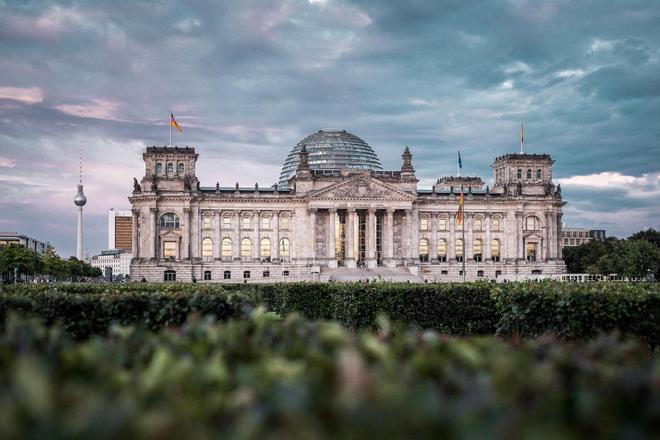
From the Brandenburg Gate you can head towards the Tiergarten, Berlin's second largest city park. In the central part of the park is the famous Victory Column (Großer Stern bus stop – bus 100, 106, 187, N26) from 1873, which can be reached by a nice walk from the Brandenburg Gate in about half an hour. To the right of the Victory Column, about two kilometres away and on the opposite bank of the River Spree, you will find the Berlin Zoo (Zoologischer Garten Bhf – U2, U9; S3, S5, S7, S9; Bus 100, 109, 110, 200, 204, 245, 249), which includes the Aquarium.
In the opposite direction from the Brandenburg Gate you can walk along Unter den Linden in about half an hour to the Mitte district in the very centre of Berlin, where you will find the Museumsinsel (stop Lustgarten – bus 100, 200), one of the most important museum complexes in the world. Cross Museum Island to the 368-metre high Berlin Television Tower (stop AlexanderPlatz – U-Bahn U5), located in the heart of the eastern part of Berlin on AlexanderPlatz, which can be reached in another 20 minutes or so.
From here, a nice walk of about an hour along the River Spree will take you to the remaining part of the Berlin Wall, the East Side Gallery (stop East Side Gallery – bus 248), which is now the only large, continuous remnant of the former Berlin Wall, formerly 165 km long, testifying to Berlin's past.
Where to eat
When it comes to food, Berlin is not your typical German city. You can sample food from every cuisine in the world, be it Mexican, Thai, Italian or Indian, and you can enjoy a kebab or currywurst rather than sausage and cabbage.
The legendary currywurst – fried sausage with curry sauce, this sausage delicacy is a must-try! You can buy it without a side dish or with chips or a bun. There's no limit to the types of sauces either – they range from very hot to slightly sweet. Currywurst will be waiting for you on every corner. Try Curry 36 near the Mehringdamm underground station or Konoppke Imbiss under the Eberswalder Strasse underground station in the Prenzlauer Berg district.
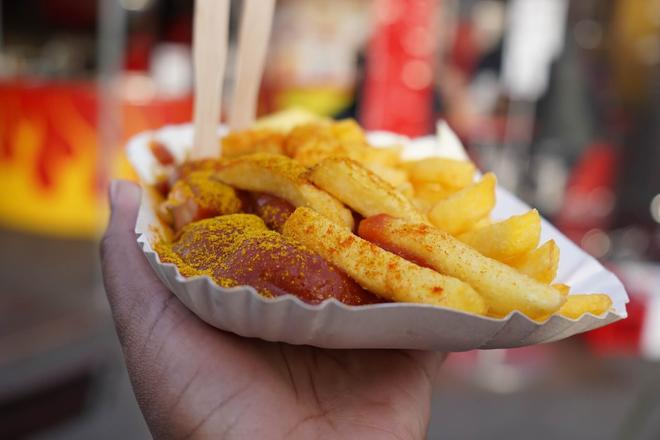
Kebabs – a dish of pieces of grilled meat (pork, chicken or lamb) wrapped in a bread pocket or tortilla with a vegetable side dish and sauce – are very popular in Berlin. The best Kebabs in Berlin can be found at Mustafas Gemuse Kebap. For burgers, head to the lauded Berlin Burger International or the Asian burger joint Shiso Burger. Burgermeister offers some of the best burgers in Berlin.
On the main street, Budapester Straße, you will find a stylish restaurant with the name Neni. The restaurant is located on the 10th floor, where you’ll have a beautiful view of the city and the Berlin Zoo. You can order from healthy dishes inspired by Persian, Arabic, Moroccan, Spanish and German-Austrian cuisine. Don't forget to make your reservation well in advance.
Right next to Neni, you'll find the Talking Beans stand, where you'll have the chance to sample a really wide range of waffles and pancakes prepared both sweet and savoury. The food will be prepared right in front of you and is definitely worth the wait.
In Berlin, you'll find hipster cafés at every turn. Many of them are open in the evening, so feel free to stay for a drink or a light dinner. The best cafés are in the Mitte district. These include the cosy café with a French atmosphere, Cafe Fleury. Friendly service, reasonable prices, good coffee, delicious desserts and a great lunch. If the weather is nice, sit at an outdoor table and watch life in Mitte. If you are a fan of good strong coffee and minimalism, the Distrikt café will appeal to you. As well as some of the best coffee in the city, you can also enjoy a delicious breakfast (muesli, pancakes, avocado toast, eggs). The cosy, rustic Bonanza café is close to the Mauer Park, where you can go for karaoke in the summer after a great cup of coffee! The Nordic-style Kaschk café will delight you if you like beer. Stick around for the evening and sample the wide selection of draft beers. Berliners love beer, so don't miss the opportunity to sample as many as you can.
Where to stay
Berlin offers a wide range of accommodation from hotels and hostels to apartments. As Berlin is a busy tourist destination, it is best to book your accommodation in advance.
Hotels
In the centre of Berlin, between the popular Mitte and Prenzlauer Berg districts, Circus Hotel offers modern rooms with private bathrooms. Guests can rent a bike at the reception to explore Berlin.
The modern Garden Living – Boutique Hotel is just 500 metres from Berlin Central Station and 2 km from the Reichstag Building, Brandenburg Gate and Museum Island. It offers a garden and rooms/apartments with a balcony. Rooms feature elegant décor, large windows and a private bathroom.
In the centre of Mitte, Gorki Apartments offers elegantly furnished apartments in a beautiful 19th-century building near Rosenthaler Square. The interiors combine designs by famous designers with distinctive flea market items and modern touches.
The Motel One hotel chain also offers good locations at affordable prices.
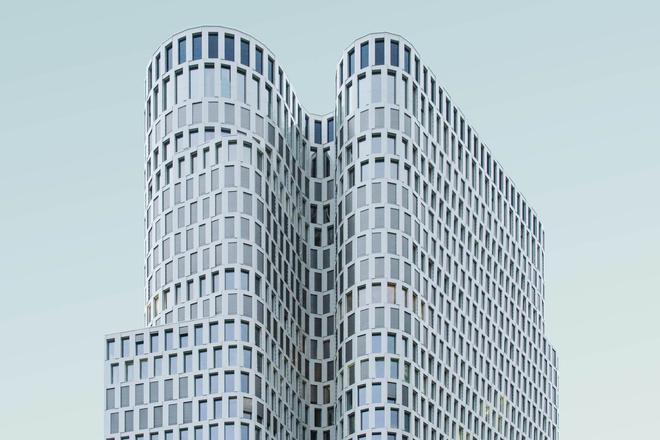
Hostels
The charming Eastern & Western Comfort Hostelboat consists of two boats moored by the river Spree in the centre of Berlin. The Eastern Comfort Hostel offers cosy cabins with en suite bathrooms and a spacious deck with a beautiful view of the Oberbaumbrücke bridge. The Western Comfort Hostel offers budget cabins with shared bathrooms and a rooftop terrace, which includes space for guests staying in tents. In summer, you can have a drink on the floating deck in the Floating Lounge, and in winter you can sit by the fireplace with your drinks. Every Wednesday there is a get-together party for people from different countries.
The 2-star Baxpax Downtown Hostel is just a short walk from Berlin's historic Friedrichstraße. It offers accommodation ranging from single rooms to five-bed rooms. During your stay, you can make use of the rooftop terrace and the Cosmo Lounge.
Nightlife
Berlin offers such a diverse entertainment scene that few cities can rival it. Fans of techno, classic rock, pop and even jazz will be in for a treat. Most of the clubs don't open until late, usually around 11pm, and don't come alive until the late morning hours. Admission usually starts at €4.
Badeschiff Treptow offers an original combination of a bar and an outdoor pool, which is covered in winter, located right on the river Spree.
On Potsdamer Platz you'll find the stylish cocktail bar 40 Seconds. With R&B or dance music, you can enjoy a beautiful view of Potsdamer Platz from the bar terrace.
The glass-walled Watergate Bar, located near the East Side Gallery, offers a beautiful view of the River Spree and Berlin's most beautiful bridge, the Oberbaumbrücke. It specialises mainly in techno and house music. DJs from all over the world often come here.
Kaffee Burger is a legendary Russian club founded in 1990. Two Saturdays a month its founding DJs play Russian hip hop, pop or rock. On other days, there are live performances, readings, film screenings, etc. It is located near Rosa-Luxemburg-Platz.
Berlin is the birthplace of techno and the Weekend-club is a techno bar in a high-rise building on Alexanderplatz.
Shopping
Berlin offers endless shopping opportunities. Whether you're looking for international designer brands, unusual and original pieces or something cheap but unique, you're sure to find just what you're after. In Berlin, you can shop in huge shopping malls with luxury goods, small shops and boutiques, and the very popular flea markets.
Shopping galleries
Berlin's largest and most famous shopping mall is KaDeWe on Kurfürstendamm, where you can enjoy exclusive shopping on six floors. Nearby you will also find the modern Bikini Berlin shopping gallery. The Mall of Berlin on Leipziger Platz offers exclusive shopping in around 300 shops, plus many snack bars, restaurants and leisure facilities. The Dussmann on Friedrichsstrasse has the largest classical music department in the world. However, jazz and pop music fans will also find something to their liking. The Lafayette Gallery is located in the famous Friedrichstrasse shopping area and focuses mainly on luxury goods. In the heart of the city, on Potsdamer Platz, you'll find the three-storey modern glass-roofed Arkaden building. On Alexandraplatz you will find the Kaufhof shopping gallery and the ALEXA Shopping centre.
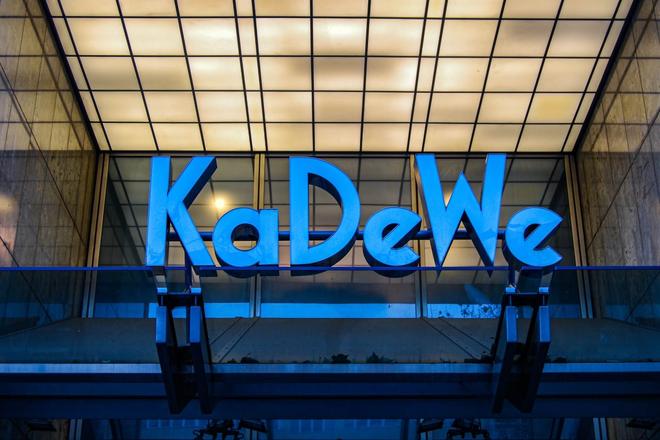
Markets
Almost every district in Berlin has its own market. Mostly cheaper jewellery, fabrics, clothes, food or flowers are sold here. It's not surprising that Berlin has its own Turkish market, the TürkenMarkt in the Kreuzberg district, given its large Turkish community. Every Thursday and Friday (11:00 – 18:30) you can buy handmade jewellery or fabrics from Middle Eastern countries, for example. Every Wednesday (8:00 – 14:00) and Saturday (8:00 – 18:00) you can buy cheap retro jewellery, scarves or hats for a few euros at the Winderfeldmarkt on Winterfeldtplatz. Old CDs, antiques, and porcelain can be bought right in the centre, on Strasse des 17.Juni near the Technical University, every Saturday and Sunday (10:00 – 17:00) at the Kunstmarkt, one of Berlin's most famous flea markets.
Tourist information
Tourist information centres at Tegel and Schönefeld airports, the main train and bus stations, offer advice on public transport, tourist attractions, help with booking accommodation and city maps. Other tourist information centres can be found at important places such as the Brandenburg Gate and Alexanderplatz.
In Berlin, you don't have to worry about getting lost, there's Wi-fi on every corner.
Important numbers
Police: 110 (free, 24/7)
Emergency medical, fire service: 112 (free, 24/7)
Lost and found
Zentrales Fundbüro (general) Platz der Luftbrücke 6 12101 Berlin-Tempelhof; 030/90277 3101
BVG-Fundbüro (public transport) Potsdamer Str. 180/182 10784 Berlin; 030/19 449
Berlin is also considered a very safe city.
What to see
As mentioned above, the Brandenburg Gate is one of Berlin's most important symbols. The 26-metre-high, 66-metre-wide sandstone structure with five passageways in the early classical style is strongly reminiscent of the propylaea of the Athenian Acropolis. Decorative ornaments and reliefs depict scenes from the life of Hercules, the god Marthas and the goddess Minerva. On top rests a five-metre high statue of a quadriga, representing the winged goddess of victory riding into the city in a chariot drawn by four horses. The Museum of the Brandenburg Gate is located right next to the gate and offers lots of interesting information.
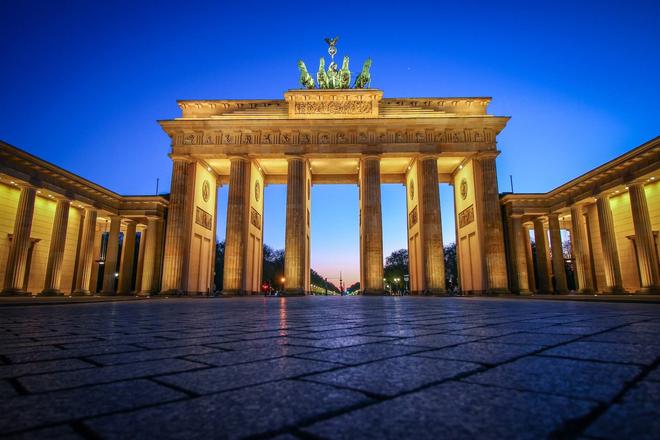
The 13,100 m² Jewish Holocaust Memorial is located in the centre of the city and commemorates the Jewish population murdered by the Nazis during the Holocaust. The idea to build the memorial first appeared in 1988, but due to the very sensitive subject matter, construction only began in 2003. The 2,711 stone blocks evoking the atmosphere of a cemetery may well bring tears to your eyes.
The Reichstag building is the seat of the German Parliament and one of the most visited places in the whole of Berlin. You can get a free tour of the beautiful terrace overlooking the entire city and Norman Foster's futuristic glass dome from 8:00am to 12:00am, you just need to book well in advance.
Berlin's TV tower, built in the 1960s, is also known locally as the Fernsehturm. At 368 metres high, it is the tallest building in Berlin and can't be missed from a distance. From the tower, you can enjoy a unique 360° panorama of the city and, thanks to the restaurant, you can also enjoy a drink or a bite to eat. Book your tickets for the tower online in advance.
The Berlin TV Tower is located in the heart of East Berlin on AlexanderPlatz, one of the liveliest places in Berlin today, with shops, cinemas and restaurants. Alongside the TV tower, you'll also find famous buildings such as the Berlin Town Hall, also known as the Rotes Rathaus after the red bricks from which it is built. Other unmissable features of Alexanderplatz include the Alexa shopping centre with more than 180 shops; the Marienkirche, the second oldest church in Berlin (after the Nikolaikirche in the Nikolaiviertel district); and the famous World Clock, which tells the time in cities around the world.
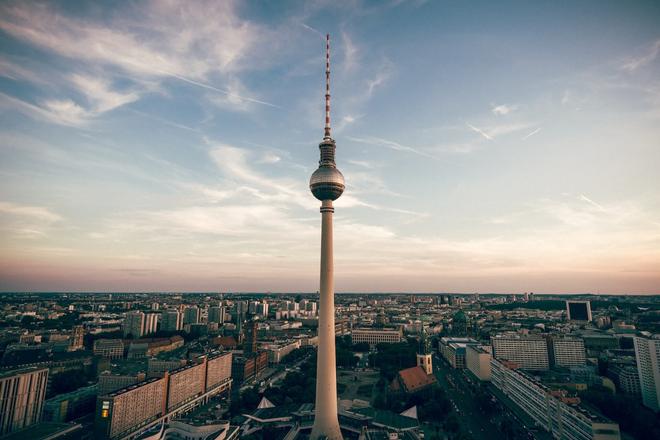
One of the most beautiful squares in the city, in the centre of which is the statue of the poet Friedrich Schiller, is the Gendarmenmarkt. Some of the capital's most architecturally impressive buildings stand here: the Baroque Deutscher Dom with its neoclassical tower and the Französischer Dom, to which a tower with a dome was also added for aesthetic reasons. The neoclassical Concert Hall was built on the ruins of the original National Theatre, which burned down in 1817, according to a design by the architect Karl Friedrich Schinkel.
The square is located near Friedrichstraße, an exclusive shopping street in the central Mitte district. One of the city's most important avenues, it is 3.5 kilometres long, and as well as shopping, you can visit the famous Checkpoint Charlie border crossing, where soldiers in period uniforms with flags of the occupying forces stand in front of the guard booth, or one of the theatres.
A remarkable example of late 19th century architecture is the Berlin Cathedral with its magnificent dome. Near the cathedral, there is also the German Historical Museum, which tells the story of 2,000 years of German history, and Museumsinsel, a complex of five museums that is a UNESCO World Heritage Site. As far as museums go, the Topography of Terror Museum, which is free, has lots of interesting photos, mainly from World War II. On the banks of Berlin's "Unter den Linden" boulevard is the Catholic Cathedral of St Hedwig with its striking dome and modern, simple interior; the Humboldt University or the Berlin State Opera.
The Kurfürstendamm is the capital's most expensive address and home to all the exclusive brands. Not far from here you'll find the Berlin Zoo, the oldest in all of Germany, which includes the Aquarium.
The magnificent Charlottenburg Castle, set in a picturesque garden with a mausoleum right by the River Spree, is the largest surviving royal complex in Berlin. It's located outside the city centre, but it's definitely worth a visit! As well as a stroll through the gardens, the palace offers a rich collection of porcelain and paintings, and you can visit the Charlottenburg Museum directly opposite.
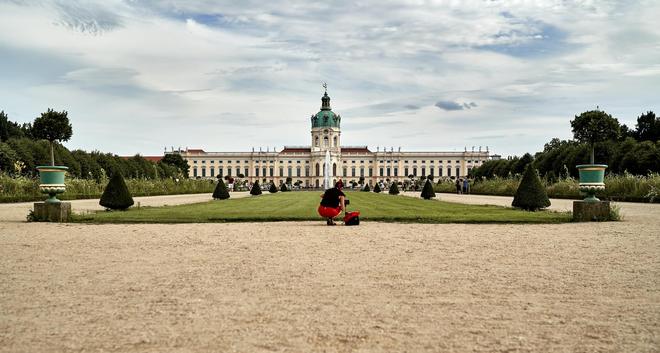
The East Side Gallery is an open-air museum located on the border of the former Berlin districts of Friedrichshain and Kreuzberg (since 2001 the two districts have been merged). Stretching along the banks of the River Spree for over 1.3 kilometres, the Wall is one of the few places in the city where you can still see the remaining pieces of the Wall, which was demolished over thirty years ago. The remaining pieces of the wall are painted with up to 106 prints by artists from all over the world. Also not to be missed is the Berlin Wall Documentation Centre, which is a national memorial to the formerly divided city and the victims who died trying to escape from East to West, as well as a place where information related to the construction and almost 30 years of the Berlin Wall is collected.
Potsdamer Platz combines modern architecture with that of a bygone era. Various companies and businesses are housed in representative buildings, dominated by the Sony Centre with its impressive glass roof, which is probably the most popular and most visited cinema in Berlin.
The Spreepark amusement park at Ostkreuz station is not to be missed. The dilapidated and long defunct Spreepark attracts with its shabbiness and obsolescence, but also with its story. On an area of 30 hectares the largest amusement park in the whole of East and West Germany was created. It thrived and attracted a million and a half visitors a year. But from the mid-1990s it began to decline, closing in 2002 and creating a very specific space that attracts lovers of mysterious corners.
Parks
As well as its unique architectural sights, Berlin also offers a number of opportunities for spending time outdoors, and its many public parks are ideal for this.
The largest and most popular park, located in the very centre of the city, is the Tiergarten. Here you will find government buildings, monuments, a lake suitable for boating, many cafes and the nearby Berlin Zoo. Berliners use the park mainly for outdoor sports or Sunday barbecues.
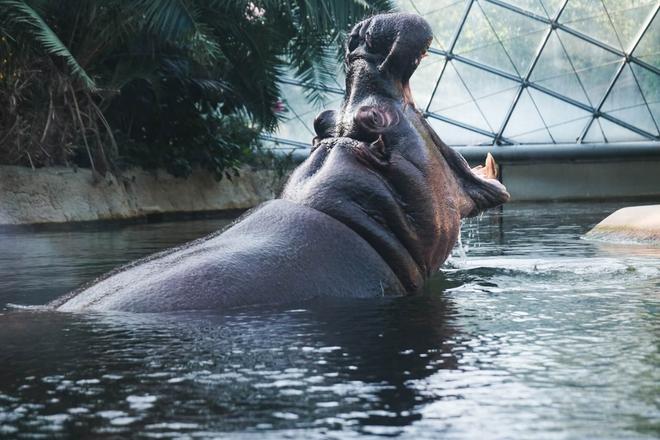
The landscaped gardens around the Chalottenburg Castle are perfect for a relaxing evening stroll, while you'll love the oldest park in the city, Friedrichshain, if you like a bit of action. There's always something going on here! Enjoy jogging, bouldering, frisbee or beach volleyball. Of course, you can also just relax on the grass or enjoy a barbecue. The large Treptower Park in the south-eastern part is situated along the banks of the river Spree, which you can use for a paddle boat ride.
Lakes
In addition to a number of parks, Berlin also offers several bodies of water, including lakes, which invite you to enjoy a variety of water sports. Probably the most popular place for recreation and water sports is Lake Wannsee, where you will find a sandy beach nearly one and a half kilometres long and more than 1,800 sunbeds for rent. Another very popular lake is Schlachtensee in south-west Berlin. It offers a beach, boat rental and dining options. You will also find quiet parts of the shoreline that are ideal for jogging or relaxing. Krumme Lanke, also in the southwest, is very popular for its clear water and picturesque setting on the edge of the Grunewald forest. In the north of Berlin you'll find Plötzensee, popular with swimmers, while Tegelersee has seven islands and is a particularly idyllic spot for boating.
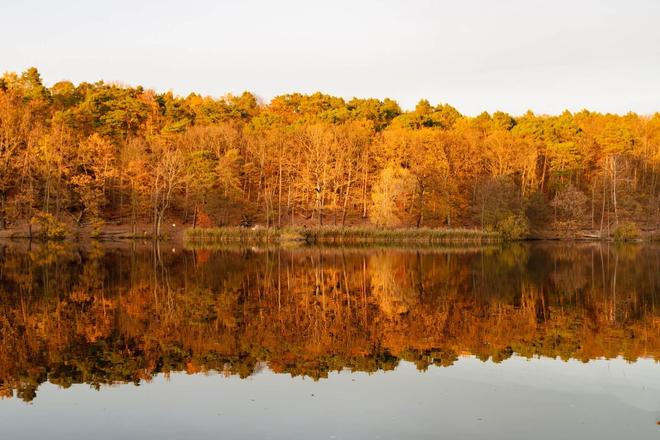
Excursions in the surrounding area
Approximately 25 kilometres from the centre of Berlin you will find the Sachsenhausen Concentration Camp. The camp was originally in the shape of a triangle, which was to be controlled from a centrally located entrance tower to symbolise the absolute power of the SS. As the capacity of about 10,000 prisoners was insufficient, the construction of additional houses was undertaken, thus disturbing the geometric form of the camp.
About 40 kilometres from Berlin, Potsdam is home to Sanssouci Castle, a summer palace that is considered a rival to Versailles in France. The rococo castle building is surrounded by remarkable gardens. The New Palace also stands on the west side of the gardens. In Potsdam you will also find the Marmorpalais, the former royal residence, and the Charlottenhof Palace, the summer residence of Crown Prince Frederik William.
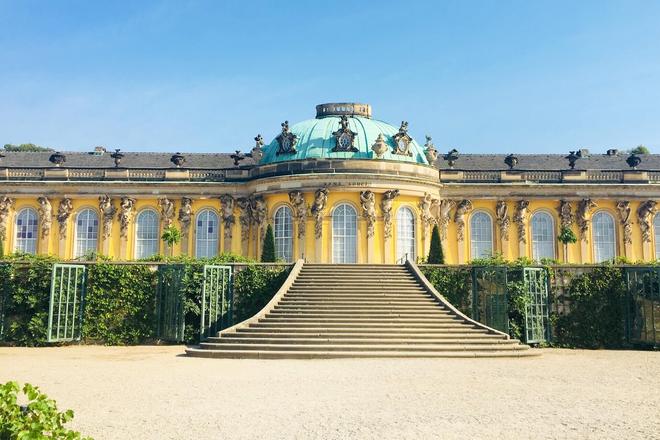
In Bernau, about 30 kilometres from Berlin, you will find the building of the Bauhaus art school.
Culture and holidays
The Berlinale is the second largest film festival in the world. It takes place every February at the Berlinale Palast near Potsdamer Platz and lasts for 14 days. Around 400 films are screened and most of them have their world or European premiere here.
Berlin is a very rich city in terms of nationalities and cultures, and every May the Carnival of Cultures is held here, where every minority living here has the opportunity to present their customs and traditions in the form of dance, music, masks and culinary arts right on the streets of the city.
The Berliner Theatertreffen is one of the most famous theatre festivals in the German-speaking world. It takes place every May and features ten "most spectacular productions", selected each year by an independent jury of critics from around 400 performances of the season.
For five evenings under a starry sky on one of Berlin's most beautiful squares, the Gendarmenmarkt, popular classical and modern melodies resonate as part of the Classic Open Air Festival.
The area around Nollendorfplatz has been known for its gay and lesbian scene since the 1920s. At the end of July, a lesbian and gay festival is held here.
